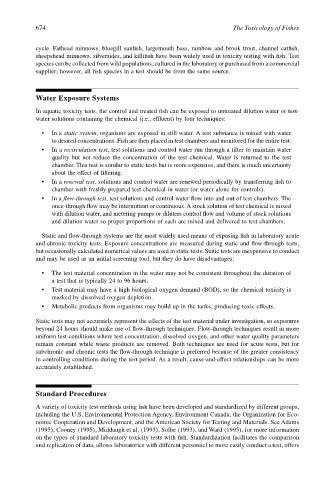Page 694 - The Toxicology of Fishes
P. 694
674 The Toxicology of Fishes
cycle. Fathead minnows, bluegill sunfish, largemouth bass, rainbow and brook trout, channel catfish,
sheepshead minnows, silversides, and killifish have been widely used in toxicity testing with fish. Test
species can be collected from wild populations, cultured in the laboratory or purchased from a commercial
supplier; however, all fish species in a test should be from the same source.
Water Exposure Systems
In aquatic toxicity tests, the control and treated fish can be exposed to untreated dilution water or test-
water solutions containing the chemical (i.e., effluent) by four techniques:
• In a static system, organisms are exposed in still water. A test substance is mixed with water
to desired concentrations. Fish are then placed in test chambers and monitored for the entire test.
• In a recirculation test, test solutions and control water run through a filter to maintain water
quality but not reduce the concentration of the test chemical. Water is returned to the test
chamber. This test is similar to static tests but is more expensive, and there is much uncertainty
about the effect of filtering.
• In a renewal test, solutions and control water are renewed periodically by transferring fish to
chamber with freshly prepared test chemical in water (or water alone for controls).
• In a flow-through test, test solutions and control water flow into and out of test chambers. The
once-through flow may be intermittent or continuous. A stock solution of test chemical is mixed
with dilution water, and metering pumps or diluters control flow and volume of stock solutions
and dilution water so proper proportions of each are mixed and delivered to test chambers.
Static and flow-through systems are the most widely used means of exposing fish in laboratory acute
and chronic toxicity tests. Exposure concentrations are measured during static and flow-through tests,
but occasionally calculated numerical values are used in static tests. Static tests are inexpensive to conduct
and may be used as an initial screening tool, but they do have disadvantages:
• The test material concentration in the water may not be consistent throughout the duration of
a test that is typically 24 to 96 hours.
• Test material may have a high biological oxygen demand (BOD), so the chemical toxicity is
masked by dissolved oxygen depletion.
• Metabolic products from organisms may build up in the tanks, producing toxic effects.
Static tests may not accurately represent the effects of the test material under investigation, so exposures
beyond 24 hours should make use of flow-through techniques. Flow-through techniques result in more
uniform test conditions where test concentration, dissolved oxygen, and other water quality parameters
remain constant while waste products are removed. Both techniques are used for acute tests, but for
subchronic and chronic tests the flow-through technique is preferred because of the greater consistency
in controlling conditions during the test period. As a result, cause-and-effect relationships can be more
accurately established.
Standard Procedures
A variety of toxicity test methods using fish have been developed and standardized by different groups,
including the U.S. Environmental Protection Agency, Environment Canada, the Organization for Eco-
nomic Cooperation and Development, and the American Society for Testing and Materials. See Adams
(1995), Cooney (1995), Middaugh et al. (1993), Solbe (1993), and Ward (1995), for more information
on the types of standard laboratory toxicity tests with fish. Standardization facilitates the comparison
and replication of data, allows laboratories with different personnel to more easily conduct a test, offers

